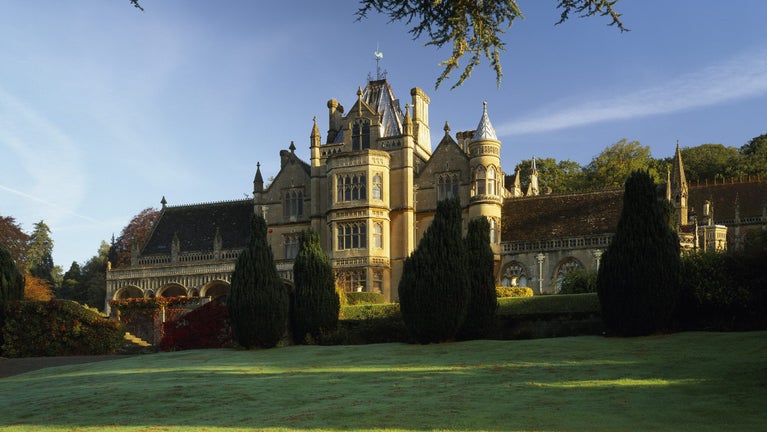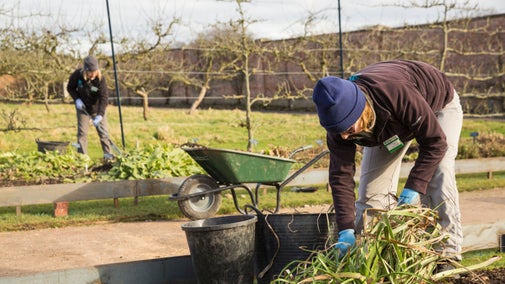
Discover more at Tyntesfield
Find out when Tyntesfield is open, how to get here, the things to see and do and more.

Relatively unchanged since 1900, the garden at Tyntesfield is varied, ranging from large open lawns and formal terraces, to a historic orangery and working Kitchen Garden. With seasonal planting throughout the year and numerous paths to follow, there's always something new to see.
As summer fades into autumn at Tyntesfield, the gardens transform with rich seasonal colour for you to explore. The Lower Gardens are brimming with gourds, pumpkins and squashes, gathered in preparation for our autumn harvest display in October, while the leaves shift to warm shades of orange and gold. Head to the glasshouses to discover plants basking in the gentle warmth as the days grow cooler.

The terraces were first created in the 1850s and were gradually improved by each member of the Gibbs family. Today's planting is much as it was in the early 1900s, when Tyntesfield was owned by Antony Gibbs.
With formal displays of bulbs and tender bedding plants, the terrace's ornamental flowerbeds create a colourful contrast with the Victorian Gothic house above them.
Nestled in the hillside, the Rose Garden is a quiet and sheltered retreat with manicured box hedging, a covered archway and colourful planting.
In the winter months, the garden is maintained and prepared for spring. Take a break in one of the Victorian gazebos and enjoy the views across the estate.
The Rose Garden's twin gazebos were in a state of disrepair when the National Trust first began caring for Tyntesfield in 2002, and many of the Victorian tiles were missing or broken. Now, thanks to careful restoration work from specialist conservators, the gazebos have been returned to their former glory and can be enjoyed once more.
We have now completed our Rose Garden restoration project after 4 years of work. We've installed metal edging to define the beds and a refreshed the path surface. The beds have been replanted with a mix of perennials including Agastache, Helenium, Penstemon and Salvia, and over 100 highly scented roses.
A new yew hedge will feature along the back of the garden, and a large herbaceous border wraps around the top lawn.
Paradise, as it was named by the Gibbs family, is an arboretum with a collection of specimen trees brought from all over the world to grow at Tyntesfield.
As well as a number of unusual and international trees, Tyntesfield is also home to many Champion Trees. These trees are significant due to their height, age, girth or another remarkable quality. Tyntesfield contains over 40 Somerset county champions, five of which are Great Britain and Ireland champions.

The Kitchen Garden has been providing fruit and vegetables for the Tyntesfield estate since the 1860s. Today, the majority of the produce is used in the Cow Barn restaurant, with the rest available to take home, for a donation, from our produce table.
Why not peek into the working buildings surrounding the Walled Garden – the potting shed, tool shed and apple store – which are still used for their original purpose? Or the Victorian glasshouses that are full of seasonal plants throughout the year?
When the National Trust first began caring for Tyntesfield in 2002, the Orangery was virtually derelict with several stone columns missing and serious damage to the roof. Today, thanks to careful restoration work by professional conservators and Architectural Stone Conservation students from City of Bath College, the Orangery has been returned to its former glory.
In front of the Orangery are the bright and colourful beds of the cut-flower garden, which would have been enjoyed by the Gibbs family and their guests from the 1890s. Today, the flowers are used by Tyntesfield's volunteers to create the flower arrangements in the house.

Find out when Tyntesfield is open, how to get here, the things to see and do and more.
From 18th-century water gardens and Arts and Crafts landscapes to intimate woodland gardens, there are so many places to discover.

Enjoy panoramic countryside views, vast woodland, heritage trees and rolling parkland on the Tyntesfield estate – a diverse area that contrasts designed landscape with wild areas.

The Gibbs family bought Tyntes Place in 1843 and transformed it into the Victorian Gothic masterpiece that exists today. Step inside the house to see rooms that reveal what life was like for those who lived and worked here.

Looking for fun family activities to do? Whether you're after outdoor games for the kids or just a relaxing picnic in nature, we've got plenty for you to enjoy.

Discover our gardeners’ top tips so you can make the most of your garden, plot or window box.
